Related Research Articles
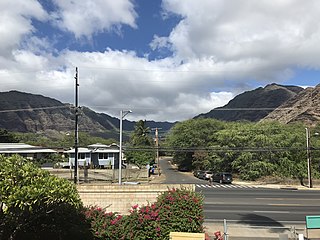
Mākaha is a census-designated place (CDP) in Honolulu County, Hawaiʻi, United States. It is a town located along the Pacific coast, west of the Mākaha Valley, and at the foot of Mt. Ka'ala in the Wai’anae Mountain Range. It is the last of the leeward towns on O'ahu. North of Mākaha there is no development, i.e. no towns, no gas stations, or restaurants. The population of Mākaha was 8,278 at the 2010 census. It is located 35 miles northwest of Honolulu, but is a part of Honolulu County.

Bodyboarding is a water sport in which the surfer rides a bodyboard on the crest, face, and curl of a wave which is carrying the surfer towards the shore. Bodyboarding is also referred to as Boogieboarding due to the invention of the "Boogie Board" by Tom Morey in 1971. The average bodyboard consists of a short, rectangular piece of hydrodynamic foam. Bodyboarders typically use swim fins for additional propulsion and control while riding a breaking wave.

Kapolei is a planned community in Honolulu County, Hawaiʻi, United States, on the island of Oʻahu. It is colloquially known as the "second city" of Oʻahu, in relation to Honolulu. For statistical purposes, the United States Census Bureau has defined Kapolei as a census-designated place (CDP) within the consolidated city-county of Honolulu.
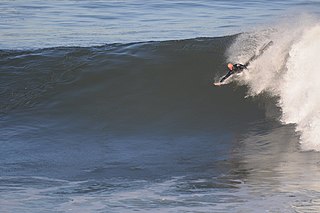
.

Big wave surfing is a discipline within surfing in which experienced surfers paddle into, or are towed into, waves which are at least 20 feet high, on surf boards known as "guns" or towboards. Sizes of the board needed to successfully surf these waves vary by the size of the wave as well as the technique the surfer uses to reach the wave. A larger, longer board allows a rider to paddle fast enough to catch the wave and has the advantage of being more stable, but it also limits maneuverability and surfing speed.

Mike Stewart is a nine-time World Champion bodyboarder, one of the early pioneers of the bodyboarding sport, a pioneer of big-wave tow-in surfing and also a champion bodysurfer.
The Triple Crown of Surfing is a Hawaii a specialty series of professional surfing events that have been held annually since 1983 on the North Shore of Oahu, a coastline whose winter swells can reach 50 feet (15 m) in height.

The Banzai Pipeline, or simply Pipeline or Pipe, is a surf reef break located in Hawaii, off Ehukai Beach Park in Pupukea on O'ahu's North Shore. A reef break is an area in the ocean where waves start to break once they reach the shallows of a reef. Pipeline is known for huge waves that break in shallow water just above a sharp and cavernous reef, forming large, hollow, thick curls of water that surfers can tube ride. There are three reefs at Pipeline in progressively deeper water farther out to sea that activate according to the increasing size of approaching ocean swells.
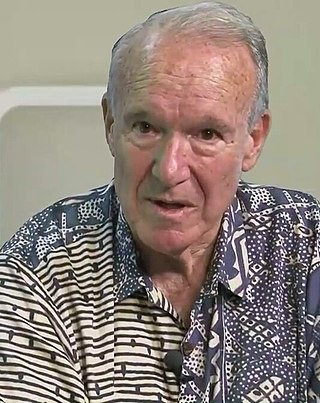
Fred Hemmings is an American surfer, author, businessman, and politician.
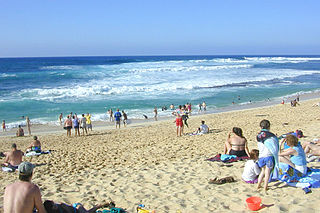
Sunset Beach is on the North Shore of Oahu in Hawaii and known for big wave surfing during the winter season. The original Hawaiian name for this place is Paumalū. It is a two-mile stretch of mostly beige sand located at 59-104 Kamehameha Highway in Pupukea, 39 miles driving distance from Waikiki. Lifeguards are usually present.
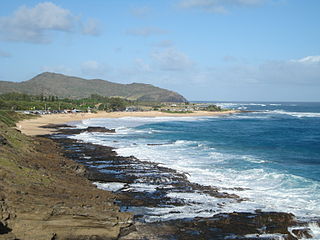
Sandy Beach is a beach on the South Shore of Oʻahu in Hawaii. It is known for its excellent bodyboarding and bodysurfing opportunities due to shore break and consistent barrels. Consequently, more injuries occur per year at Sandy Beach than any other beach in Hawaii, earning it the infamous nickname, "break-neck" beach. The water is especially dangerous during high surf, when strong rip currents are present. The beach park is located between Hanauma Bay Nature Preserve Park on the west and Makapuʻu Point on east along 8800 Kalanianaole Highway in Honolulu's southside neighborhood.
"The Eddie", also known as The Eddie Aikau Big Wave Invitational, is a big wave surfing tournament held at Waimea Bay on the north shore of Oahu, Hawaii. The tournament is named for native Hawaiian, champion big wave surfer, and life-saving Waimea Bay lifeguard, Eddie Aikau. Created in 1984 at nearby Sunset Beach, the invitational tournament moved to the notoriously big waved Waimea Bay, where Aikau's family maintains an ancestral tradition as caretakers of the Waimea Valley. It was formerly known as the Quiksilver in Memory of Eddie Aikau after its sponsor Quiksilver, but the company and the Aikau family could not agree to terms for a new contract after the previous one expired in 2016.
The Patsy T. Mink Central Oahu Regional Park (CORP) is a 269-acre (1.09 km2) public park operated by the City and County of Honolulu. It held its grand opening on July 21, 2001 and it is located in Waipio, Oahu just off the Kamehameha Highway.
The O'Neill World Cup of Surfing is a prestigious event in professional surfing held annually at Pūpūkea on Oahu in Hawaii.
The Billabong Pipeline Masters is an event in surfing held annually at Banzai Pipeline in Oahu, Hawaii. It was established in 1971, and has been sponsored by Billabong since 2007.
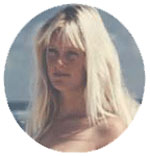
Carol Philips is a pioneer of big-wave bodyboarding for women. She was the first woman to compete against the men at the Banzai Pipeline on the North Shore (Oʻahu). She founded the World Championship of Women's Bodyboarding in memory of Don and Josie Over in 1990. She was the first woman to hold a permit to run a contest at the Banzai Pipeline. Philips is the founder of the North Shore Surf Girls - Surf School.

The North Shore, in the context of geography of the Island of Oʻahu, refers to the north-facing coastal area of Oʻahu between Kaʻena Point and Kahuku. The largest settlement is Haleʻiwa.
Balaram Stack is a professional surfer. He was born on September 5, 1991. The youngest of three surfing brothers, Stack was born in Sebastian, Florida, where he began riding waves on a boogie board at three. His family relocated to Long Island when he was five, settling a half-block from the beach in Point Lookout.

Dog surfing is a type of surfing maneuver involving dogs that are trained to surf on surfboards, bodyboards, skimboards, windsurf boards or to bodysurf. Historically, surfing dogs have been documented as occurring as early as the 1920s in the United States. Competitions and exhibitions that feature surfing dogs have occurred in various coastal areas of the United States, such as Del Mar, California, Imperial Beach, California and Jupiter, Florida.
References
- ↑ About event origin
- ↑ The Encyclopedia of Surfing, 2005, Matt Warshaw, Harcourt Books, ISBN 0-15-100579-6
- ↑ http://www.pipebodysurf.com/12_19_06_release/ PBC 2007 was not held